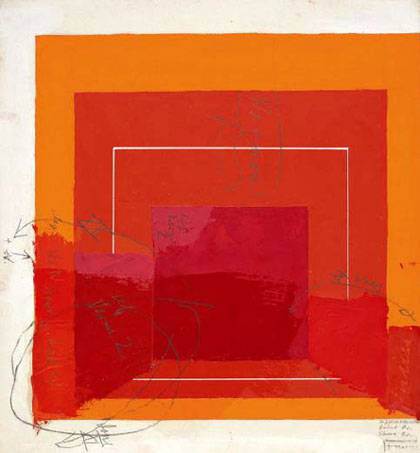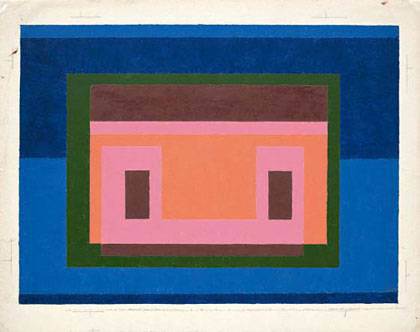
Josef Albers (1888–1976)
Color Study for White Line Square, not dated
Oil on blotting paper (with gouache, pencil, and varnish)
29.53 x 29.66 cm
© 2012 The Josef and Anni Albers Foundation / Artists Rights Society New York
Digital Image by Imaging 4 Art
inv. no. 1976.2.22

Josef Albers (1888–1976)
Variant / Adobe, 1947
Oil on blotting paper
48.3 x 60.9 cm
© 2012 The Josef and Anni Albers Foundation / Artists Rights Society New York
Digital Image by Imaging 4 Art
Josef Albers in America: Painting on Paper Josef Albers in America: Painting on Paper, on view at the Morgan Library and Museum from July 20 to October 14, 2012, offers a revealing look at Josef Albers’ investigation of form and color]]>
Source: Morgan Library & Museum
The exhibition begins with studies for abstract geometric compositions from the late 1930s, when Albers—a onetime instructor at the Bauhaus— returned to painting after having devoted his recent years to working with glass. Albers’s studies for the “Variant / Adobe” series, from the 1940s, reveal the influence that his time in Mexico, and specifically the country’s pre-Columbian architecture, had upon his art. The majority of the exhibition—over fifty works—is devoted to the Homage to the Square series (1950–1976). These vibrant sketches—never exhibited in the artist’s lifetime and rarely seen after his death—provide important insight into Albers’s working method and, in contrast to the austerity and strict geometry of the finished paintings, are remarkable for their freedom and sensuality.
Painting on paper
Born in Bottrop, Germany in 1888, Albers came from a family of craftsmen, and the virtues of craftsmanship—precision, discipline, and technical proficiency—were of central importance to his work. Whereas his paintings themselves took only a few hours to complete, Albers’s preparatory work entailed producing series upon series of meticulous studies. In 1933, the Bauhaus was forced to close under pressure from the new Nazi government. Albers and his wife, Anni, immigrated to America, where he would head the art department of Black Mountain College in North Carolina. In the United States, Albers matured as a painter as his fascination with geometric form grew and his travels took him to Mexico, a place that would have a lasting influence upon his work.
Mexico and the variants/adobe series
The Albers’ visited Mexico for the first time in 1935. They returned to the country regularly over the next several decades, sometimes staying for several months. The profound effect of Mexico’s colors and pre-Columbian architecture and sculpture upon Albers’s work is difficult to overestimate. “Mexico,” he wrote to Nina and Wassily Kandinsky in 1936, “is truly the promised land of abstract art.” Mexico reconfirmed Albers’s faith in the expressive power of color, and it was here—after years of producing nothing but stained glass, furniture designs, woodcuts, and linocuts—that Albers returned to painting. He significantly expanded his color range, incorporating magenta, turquoise, violet, and ocher, among other colors, in varying combinations.
Homage to the square
In 1950, Albers found the ideal vessel through which to explore his fascination with the interaction of color: a group of nested squares. Like the Adobe series, it is possible that Homage to the Square evolved from Albers’s preoccupation with the ancient architecture and sculpture of Mexico. His main concern in these paintings, however, was not the form of the square itself, but rather color. “I’m not paying ‘homage to the square’”, said Albers, “It’s only the dish I serve my craziness about color in.” As evidenced in the notes Albers sometimes wrote in the margins of a work, or at times within the color field itself, these studies were essentially experimenting nature.
Related content
Dan Flavin: Drawing, at the Morgan Library and Museum (exhibition, 2012)
Follow us on:


